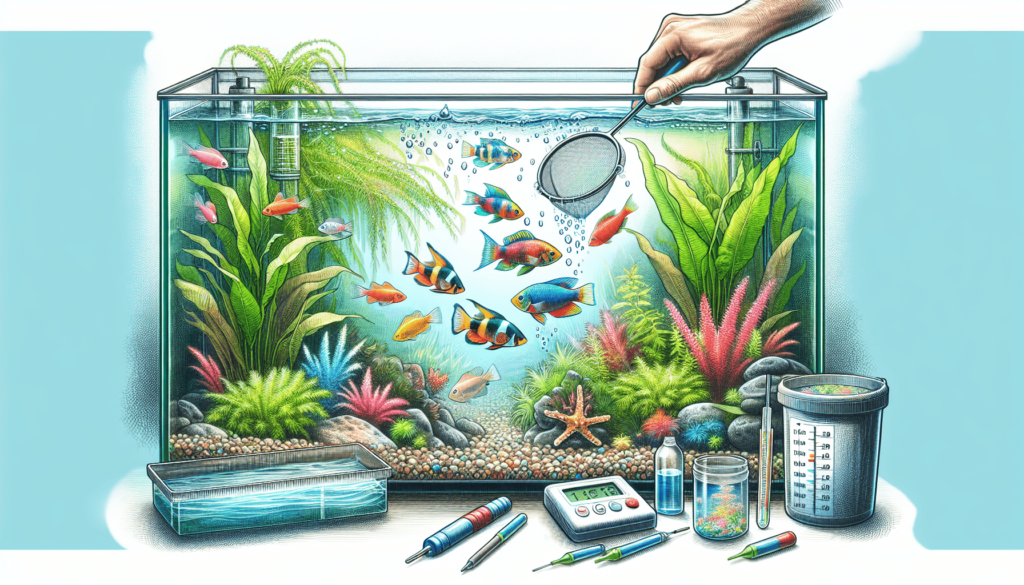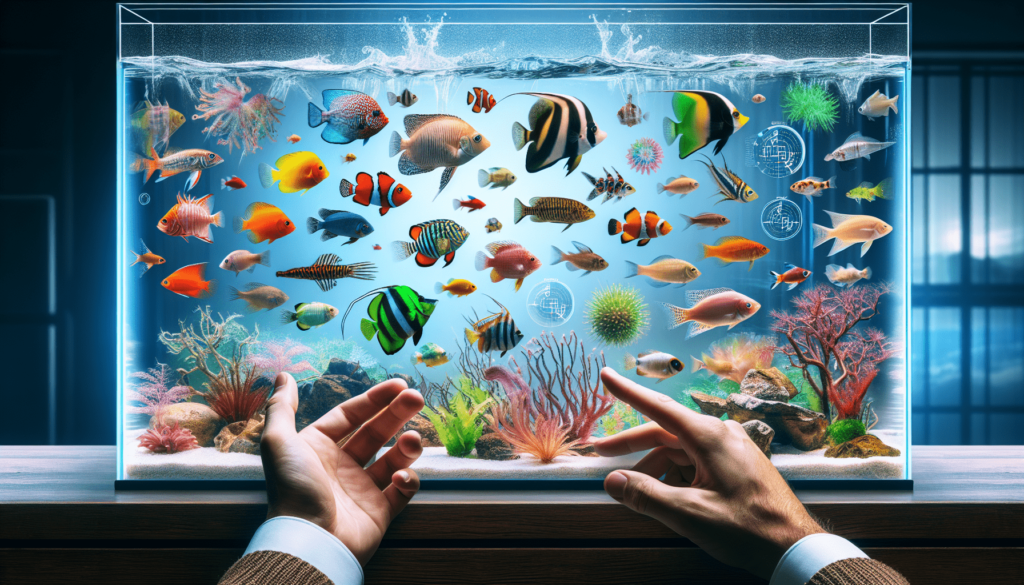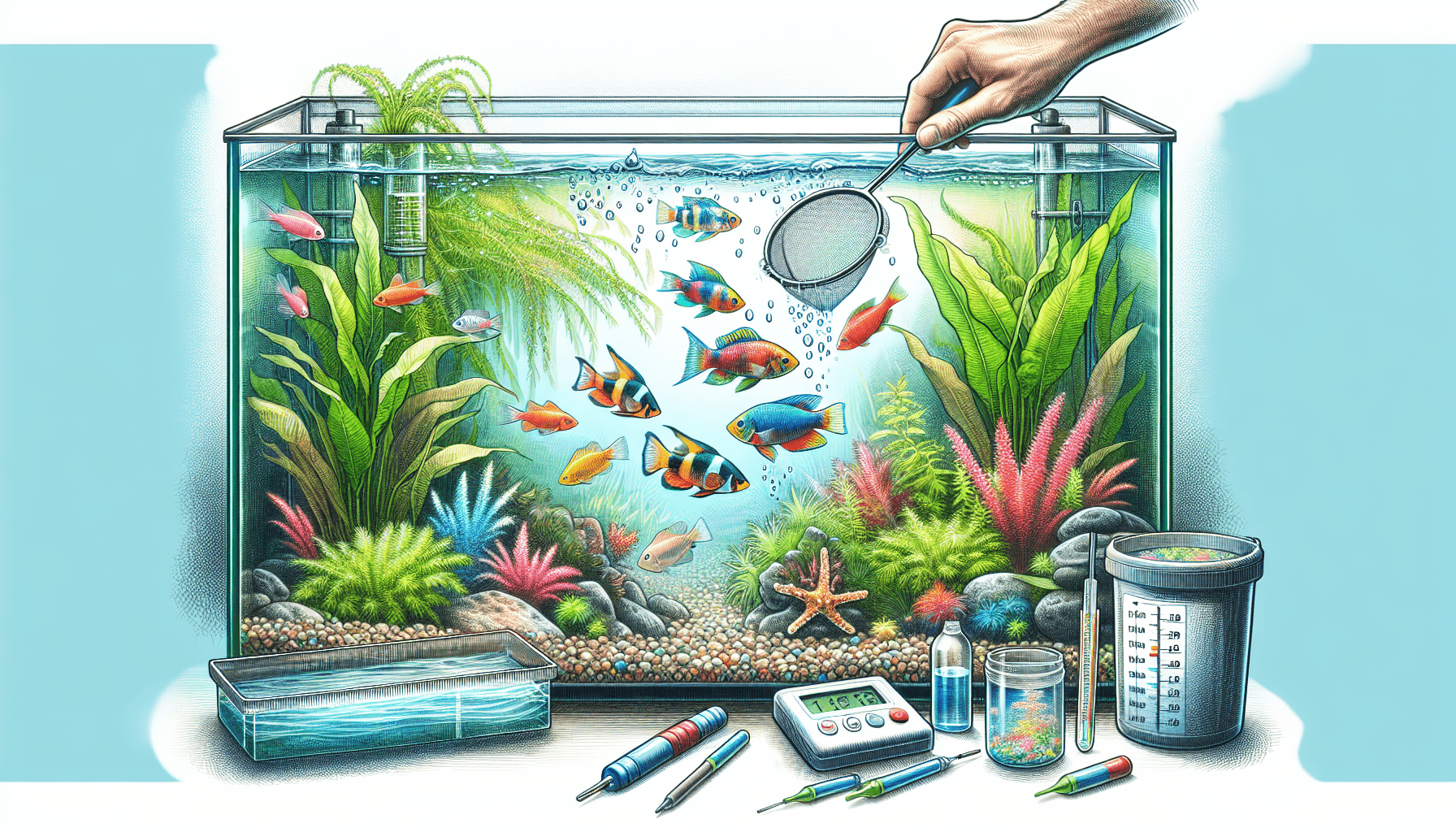Are you wondering how long you should keep your fish in a bag before transferring them to their new tank? If so, you’re not alone! Many new aquarium owners are uncertain about the appropriate duration for acclimating their fish. In this article, we will provide you with some helpful tips and guidelines to ensure a smooth transition for your aquatic pets. So, let’s dive in and learn the ideal time to leave fish in a bag in the tank!

Preparation
Before introducing your new fish to its new home, there are a few essential steps you should take to ensure a smooth acclimation process. This preparation involves acclimating the fish and gathering the necessary equipment.
Acclimating the fish
Acclimating your fish is crucial to help them adjust to their new environment. This process allows the fish to gradually adapt to changes in temperature, water chemistry, and lighting. By acclimating them properly, you can minimize stress and increase their chances of a successful transition.
Gathering the necessary equipment
Before you start the acclimation process, it’s important to gather all the equipment you’ll need. Some essential items include a clean bucket, fish net, airline tubing, air control valve, drip line, and a water testing kit. Ensuring you have these tools readily available will make the acclimation process much more convenient and efficient.
General Guidelines
When acclimating your fish, it’s important to follow some general guidelines to ensure their well-being. These guidelines include the duration for adjusting to temperature, water chemistry, and lighting.
Duration for adjusting to temperature
Temperature adjustment is crucial because abrupt temperature changes can be harmful to fish. You should aim to gradually match the temperature of the water in the bag with the temperature of your tank. This process usually takes around 15 to 30 minutes, but it may vary depending on the sensitivity of the fish species.
Duration for adjusting to water chemistry
Water chemistry plays a vital role in fish health, and sudden changes can stress the fish or cause harm. It’s important to let the fish acclimate to the water chemistry of your tank slowly. This process generally takes around 30 to 60 minutes, but again, it may vary depending on the species’ sensitivity.
Duration for adjusting to lighting
Lighting conditions can also impact fish acclimation, especially if they were previously exposed to significantly different lighting. To minimize stress, it’s recommended to dim the lights in your aquarium for the first few hours, gradually increasing the intensity over time. This process generally takes several hours to a day.
Fish Bag Float Method
One common method of acclimating fish is the fish bag float method. This method involves slowly equalizing the temperature of the water in the bag with the tank water.
Step 1: Float the bag
Start by floating the sealed bag containing your new fish in the aquarium. This allows the temperature of the water inside the bag to gradually adjust to the tank’s temperature.
Step 2: Observe temperature adjustment
Keep a close eye on the bag to observe the temperature adjustment process. This usually takes around 15 to 30 minutes. Make sure the bag remains stable, not tipping over or submerging too much.
Step 3: Gradually add tank water
After the temperature has equalized, it’s time to gradually introduce tank water into the bag. Open the bag and add a small amount of tank water every five minutes, allowing the fish to acclimate to the water chemistry.
Step 4: Assess fish behavior and readiness
Observe the behavior of the fish during this process. Once the fish appears calm and exhibits normal swimming behavior, it is likely ready to be introduced to the tank. Carefully use a net to transfer the fish from the bag into the aquarium.
Drip Acclimation Method
The drip acclimation method is another popular technique for acclimating fish. This method allows for an even more gradual adjustment of water parameters.
Step 1: Secure the bag
Similar to the fish bag float method, start by floating the sealed bag in the aquarium to equalize the temperature.
Step 2: Set up the drip line
Using airline tubing, set up a drip line from your tank to the bag. Make sure to attach an air control valve to regulate the flow of water.
Step 3: Adjust the flow
Adjust the flow of water to a rate that produces approximately two to four drips per second. This slow and steady drip allows for an even more gradual adjustment of water parameters.
Step 4: Gradually acclimate the fish
Let the drip acclimation process continue for approximately one to two hours or until the water in the bag has doubled in volume.
Step 5: Introduce fish to the tank
Once the drip acclimation process is complete, carefully transfer the fish from the bag to the aquarium using a net. Be gentle to avoid causing unnecessary stress.

Specific Fish Considerations
Different types of fish may require specific acclimation techniques due to their unique needs and sensitivities. Here are some considerations for acclimating saltwater fish, freshwater fish, and sensitive or delicate species.
Saltwater fish acclimation
Saltwater fish typically require more precise water chemistry adjustments, including salinity levels. It’s important to take extra care when acclimating them, monitoring the salinity and pH levels carefully.
Freshwater fish acclimation
While freshwater fish generally have a wider tolerance for water chemistry changes, it’s still important to acclimate them gradually to avoid any unnecessary stress. Follow the general guidelines mentioned earlier, and monitor their behavior closely.
Sensitive or delicate species
Certain fish species, such as certain reef fish or rare and fragile species, may be more sensitive to changes in water conditions. It’s crucial to research their specific requirements before acclimating them. Consulting with an expert or experienced aquarist can provide valuable guidance.
Factors Affecting Acclimation Duration
The duration of the acclimation process can vary based on several factors. Understanding these factors can help you gauge the appropriate duration for your specific fish.
Species-specific traits
Different fish species have varying levels of sensitivity to environmental changes. Some species may require a longer acclimation period, while others may adjust more quickly.
Water parameter differences
If the water in the bag and the tank have significant differences in temperature, chemistry, or salinity, the acclimation process may need to be extended to allow for a more gradual adjustment.
Fish sensitivity
Individual fish may have different levels of sensitivity, even within the same species. Monitoring their behavior during the acclimation process can help you determine if they need more time to adjust.
Expert Recommendations
To ensure the best possible acclimation outcome for your fish, it’s helpful to consider the recommendations of professionals and the advice of the aquarist community.
Professional opinions
Aquarium professionals, such as marine biologists or experienced aquarists, are well-versed in fish acclimation techniques. Research their recommendations and consider incorporating their advice into your acclimation process.
Aquarist community advice
The aquarist community is a valuable resource for gaining insights and tips from fellow fish enthusiasts. Online forums, fishkeeping groups, and local fish stores are excellent places to seek advice and recommendations based on collective experiences.
Signs of Successful Acclimation
Once your fish has been properly acclimated, there are several signs to look out for to ensure the process was successful.
Active and responsive behavior
A fish that has successfully acclimated will exhibit active and responsive behavior in the tank. They should be swimming smoothly and exploring their surroundings with curiosity.
Normal breathing and swimming
Observe the fish’s breathing and swimming patterns. Normal breathing should be steady and consistent, while swimming should be coordinated and purposeful.
Preparedness to eat
Fish that have successfully acclimated should show an appetite for food. They should display interest in feeding and consume their meals without hesitation.
Potential Risks and Precautions
While the acclimation process is generally safe, it’s important to be aware of potential risks and take necessary precautions to minimize any harm to the fish.
Over-acclimation risks
Prolonged acclimation periods can potentially stress the fish unnecessarily. If the fish appears overly lethargic or weak after the recommended acclimation time, it may be an indication that the process has gone on for too long.
Under-acclimation risks
Insufficient acclimation can shock the fish and lead to health issues. Make sure to take the necessary time to acclimate your fish using appropriate techniques and closely monitor their behavior throughout the process.
Handling stressed or aggressive fish
Occasionally, a fish may show signs of stress or aggression during the acclimation process. In such cases, it’s crucial to handle them with care and ensure your own safety. Using a fish net or seeking assistance from another person can help manage the situation safely.
Observing quarantine procedures
To protect existing tank inhabitants from potential diseases, it is recommended to quarantine newly acquired fish before introducing them into the main aquarium. This ensures any health issues can be addressed before potentially affecting other fish.
Conclusion
Properly acclimating your fish is vital to their health and well-being in a new aquarium. By following the appropriate acclimation methods, carefully monitoring your fish, and considering expert recommendations, you can increase the chances of a successful transition. Remember to be patient and observant throughout the process, and always prioritize the comfort and safety of your fish. Happy fishkeeping!

My name is James Gheen, and I am thrilled to welcome you to Tropical Fish Farmers, the ultimate destination for everything related to tropical fish breeding. As an avid underwater enthusiast, I am dedicated to sharing my knowledge and experience to help you successfully breed and care for tropical fish. Whether you’re a beginner starting your aquarium journey or a seasoned breeder looking to expand your knowledge, my website has something for everyone. Dive into our extensive library of articles, tutorials, and videos covering various topics to enhance your breeding success. Join me in our vibrant community and let’s contribute to responsible fish breeding and conservation efforts together. Discover Tropical Fish Farmers and become part of our global community today.

